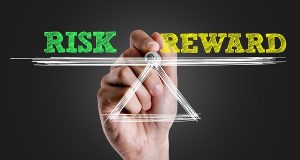The Relationship Between Risk And Reward
 You’ve heard the adage “no risk, no reward,” but is this theory really founded in sage investment advice? Actually, yes. There is some verifiable data that backs up this piece of conventional wisdom.
You’ve heard the adage “no risk, no reward,” but is this theory really founded in sage investment advice? Actually, yes. There is some verifiable data that backs up this piece of conventional wisdom.
An analysis of investment opportunities available to you as of today clearly shows a correlation between the potential return one can earn on an investment, and the potential for loss of the investment capital.
Understanding the relationship between risk and return can help you build a strong portfolio that is able to weather the ebbs and flows of the global market.
What is a Risky Investment and What is a Safe Investment?
To be clear, no investment is 100% safe. Even the money you stash in your savings account carries some level of risk with it. Your bank, just like any other business, could suffer under the weight of poor management decisions and go bankrupt.
When this happens, your money is of course insured by the FDIC—up to a certain amount. But even with insurance, the time it could take, in a worst case scenario, brings with it the opportunity for complications to arise and separate you from your money.
The risk of that happening, is very low though, making savings accounts a fairly safe investment.
One of the safest types of investments on the market are short term government bonds. Because these are backed by established governments, it is highly unlikely that the investment will go unreturned.
This 3-month US bond is so safe, in fact, that it’s often called a risk-free investment. There would need to be a major shift in the balance of world powers to default on these bonds.
The downside to such safe choices is that they offer an equally safe return. According to Bankrate, the national average for interest rates on savings accounts hovers around just 0.09%. A study by NYU found the average return on a 3-month US treasury bond in 2019 was 1.55%.
For a more exhaustive list of the least risky investments, check out our article ranking your options.
On the other end of the scale, short term investments on stocks and direct investments into budding companies often represent the highest potential returns for investors.
At the same time, if you’re investing in the stock market it’s actually more likely that you will lose money than gain. Most investors in stocks actually experience a loss in purchasing power by 2-3% on individual stocks each year.
With this high probability of loss, also comes a low possibility of a very high gain. Coty Inc. (COTY) dished up a 99.39% gain for investors in 2019. But investors who experienced this boon had no concrete evidence that the company would perform this well going into 2019.
The investment, based on the understanding that you’re more likely to lose on individual stocks than gain, was a considerable risk.
Diversification Helps Improve Returns and Lower Risk
The relationship between risk and return is fairly clear from the practical evidence. But what exactly does that information encourage you to do as an investor?
The correlation indicates a need for a balanced set of investments. Your portfolio should include a mix of low and higher-risk investments to give you the best possible total return.
When comparing a fully diversified portfolio and an undiversified portfolio with the same expected returns, the fully diversified portfolio of investments delivers gains to the investor far more consistently than the undiversified portfolio.
By spreading out your money across varying levels of risk to achieve a specific return, you can expect better total outcomes for your money.
Goal Oriented Investing
One of the most difficult to overcome barriers to investing is the idea that the field of knowledge is large and undefined. Ambiguity on how to start, uncertainty on how to evaluate risk, and confusion on what you can realistically achieve all stop people from investing in the various markets.
If you understand the risk versus return relationship, you can change your approach to investments and overcome many of these hurdles.
Most of us already have some form of investment. Even if we’ve only got a savings account or a mortgage, you’re probably invested in something already, meaning that your personal portfolio probably has room for diversification and thus, improvement.
Start by assessing your current annual returns. Consider your annual interest rate on savings and checking accounts. Explore how much you’re getting back in the form of cashback rewards on credit cards.
Once you quantify how much you’re already earning, you can design a goal for your money. Try to beat your current returns, even by a fraction of a percent, by spreading your money across different sources.
If your savings account returned 0.09% last year, purchasing a short term government bond could give you a considerable gain if you devote a portion of your funds to this alternative stream of income.
The gains you can expect from these more conservative channels of investment can give you the freedom to try your luck with more volatile forms of investments.
The Takeaway
You know that a bigger investment risk can sometimes—’sometimes’ being the keyword here—translate into bigger gain for your portfolio. However, now that you understand the concept of balance that is observed by successful investors, you can apply it to your own money management strategy.
Spreading your investments across a variety of risk levels is crucial for maintaining a healthy savings and investment portfolio.
Note: This article originally appeared at MoneyMiniBlog.
Category: Investing in Penny Stocks




